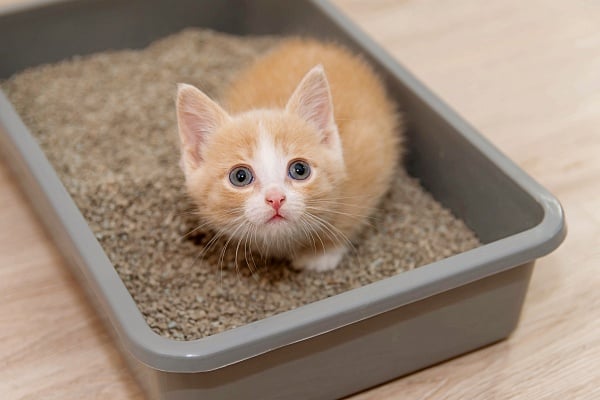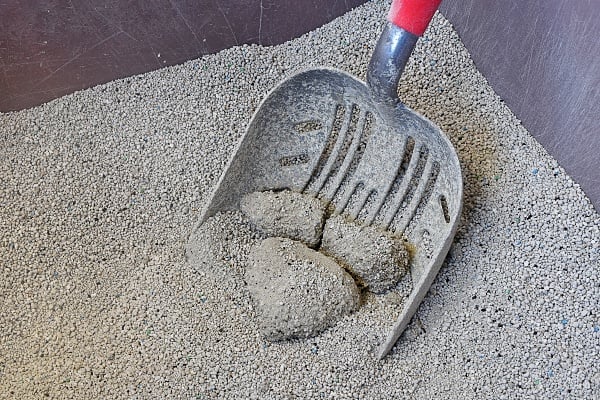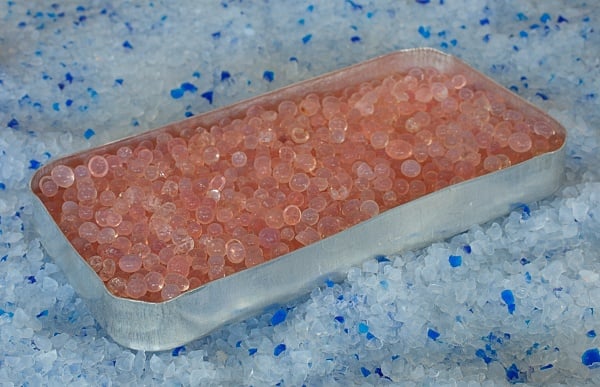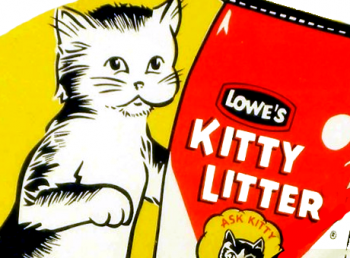When it comes to filling your cat’s litter box, there are two types of cat litter: clumping and non-clumping. Clumping litter is made from clay or silica gel, and it forms clumps when your cat urinates on it. It also sticks to their feces which makes cleaning their box a little easier. Non-clumping cat litter, on the other hand doesn’t cling to your feline friends waste to form clumps, it absorbs some of the moisture from their urine.
In this comprehensive guide, you’ll learn the differences between the two types of cat litter, pros and cons of each, and which type may fit you and your cat best.

Table of Contents
Clumping Litter

There are two types of clumping cat litter, silica gel based and clay based. The first is commonly known as crystal latter is made with bentonite clay which is known to be highly absorbent. Bentonite clay is commonly mixed with sodium bentonite which is super absorbent. It can expand up to 12 times its size.
Crystal cat litters are a popular option as it is better at reducing litter box smells. It can also be more cost effective as you scoop less out every time you clean your cat litter box. It makes less dust and is made from silica gel. The downside is some cats (like one of our males) doesn’t like how it feels on his paws. So try a small bag of crystal litter to test with your cats first.

Clumping litter pros
Clumping types of litter have a number of advantages over non-clumping litter. It’s a very popular choice of the pet owners we see. This is because it absorbs the urine into clumps. It’s easier to keep the litter box clean as you can simply remove the solid clumps and leave the rest of the clean litter in the litter tray. This can save you time and money on how many litter clumps you are discarding with your cat’s waste. This type is also better at odor control than non-clumping cat litter. This is because the tight clumps trap cat urine and solid waste which prevents it from spreading throughout the litter mat.
Clumping litter cons
However, clumping litter also has some disadvantages. It can be dustier than non-clumping litter. This can be a problem if you are like us that suffer from respiratory issues like allergies and asthma. It’s also typically more expensive than non-clumping litter.
Non-Clumping Cat Litter

Non-clumping cat litter, often referred as an absorbing litter, is the oldest commercial cat litter on the market. It was invented back in the late 1940s. Due to its great absorption capabilities compared to sand or ash (which were the alternatives back then), it gained in popularity quite rapidly. However, when clumping litter was invented in 1984, the popularity of clay started to decrease. Natural cat litters are made from things like corn kernals, walnut, and pine. You can even find wheat litter. These will also have good odor control with their natural scent. Currently, clay litter still takes up significant space on the shelves in pet stores all over the world. However, when clumping litter was invented in 1984, the popularity of clay started to decrease. This type works by absorbing many times its weight in liquid.
Non-clumping litter pros
The good part about absorbing litter is that it is less dusty than clumping litter, which is the closest alternative. It still creates a significant amount of dust, not to mention it’s quite unpleasant dust. However, a lower amount of dust is the first thing people notice when they switch from clumping to non-clumping litter. This can be a benefit for people like us that have respiratory problems.
This litter is also typically less expensive than the clumping type. Additionally, many of these are natural litters made from a variety of materials, such as corn or wheat. This can be a more appealing option for some people.
Also, a good point for this type is it’s appeal to your cats. It’s easy to dig in, and stepping on it feels natural for cats. But the bad part here is that your difficulties in maintaining a clean litter box may distract your furry friend. Unfortunately, we often experienced an accumulation of urine at the bottom of the box, which made cleaning of the box messier. As mentioned above, this may force your cat to seek a nicer place to eliminate, like your laundry basket (or at least that’s what one of our cats did). This may be solved by refilling the whole box with fresh litter more often.
Non-clumping litter cons
Firstly, it’s harder to scoop. This is because you have to scoop out a significant portion of the entire litter box every time you clean it. This can be more time consuming and messy. This is because it absorbs the liquid waste so you have to remove all of it to remove the urine soaked litter. Non-clumping litter is also more likely to be tracked out of the litter box as it can get caught in your cat’s paws. This can make the area around the box dirtier. So definitely don’t put litter boxes on carpet. That’s good advice no matter what type you use. Additionally, non-clumping litter is typically not as good at odor control as clumping litter. Our cats for example really like a fresh and clean box so we have to clean them often. Their sense of smell is 14 times stronger than ours so if you smell it, can you imagine what your cat smells?
The price of the non-clumping cat litter may also be the reason why many cat owners still choose it. If you look around the store, absorbing litter will probably be the cheapest per bag among all the different types. The economical use of clumping litter pushes non-clumping litter into the second spot in the competition of lowest cost. Of course, this varies from brand to brand.
The odor fighting capabilities of clay cat litter are mediocre. However, we always state that no matter the litter type, the best solution to a smelly litter box is frequent cleaning. You can find more tips to prevent a litter box from smelling here. If you seek a litter type that overwhelms odor well, you may create litter box avoidance in your cat, as, unlike humans, our pets do not appreciate litter boxes smelling like lavender, rose or pine.
The environmental friendliness of clay litter is not as low as that of clumping bentonite litter, but if you are an owner who cares about this issue, you may find pine, recycled paper or biodegradable clumping litter a lot better choice. The other concern is that it can swell up when in contact with moisture and increase the space it takes in our waste cans and landfills.
Which Type of Litter is Right for You?
The best type of litter for you will depend on your individual preferences and needs. If you are looking for a something that is easy to scoop and has good odor control, then clumping litter is a good option. If you are concerned about dust control, then non-clumping litter may be a better choice. The biggest difference between the two is price (clumping tends to be more pricey). Oh, and remember that your furry friend has to like what you put into their box as well. If they avoid their box or kick out litter, you may have to try a different type. If your cat or cats tend to eat their feces, a good rule of thumb is to use non-clumping options.
Ultimately, the best way to decide which type of litter is right for you is to try a few different types and see what works best for you the cat parent and your cat.
Additional Factors to Consider
In addition to the pros and cons of clumping vs non-clumping litter, there are a few other factors to consider when choosing a litter for your cat. These include:
- Your cat’s preferences: Some cats prefer one type of litter over another. If you have a cat that is picky about their litter, you may need to try a few different types to see what they like best. For example, non-clumping tends to have bigger kernels than the clumping options.
- Your lifestyle: If you have a busy lifestyle, you may prefer a litter that is easy to scoop and doesn’t track outside of the box as much.
- Your budget: Litter prices can vary depending on the type of litter and the brand. If you are on a budget, you may want to choose a non-clumping litter.
Summary
Detailed comparison chart of clumping and non-clumping litter:
| Feature | Clumping Litter | Non-Clumping Litter |
|---|---|---|
| Ease of scooping Odor control Dustiness Cost Natural materials Tracking | Easy Good Dusty More expensive Not typically made from natural materials Less likely to track | Hard Not as good Less dusty Less expensive May be made from natural materials More likely to track |
You’ve learned the differences between the two types of cat litter, pros and cons of each, and which type may fit you and your cat best. This will go a long way towards a healthy and happy life together with your pet cat. And keeping your Pet Happy is what we all want.
FAQ
Question: What are the two types of cat litter mentioned in the article?
Answer: The two types of cat litter are clumping and non-clumping.
Question: What is clumping litter made from, and what does it do when a cat urinates on it?
Answer: Clumping litter is made from clay or silica gel, and it forms clumps when a cat urinates on it.
Question: What are the advantages of clumping litter?
Answer: Clumping litter is easier to clean as it allows for the removal of solid clumps, provides better odor control, and reduced litter box smells.
Question: What are the disadvantages of clumping litter?
Answer: Clumping litter can be dustier than non-clumping litter, and it is typically more expensive.
Question: What is non-clumping cat litter made from, and how does it work?
Answer: Non-clumping cat litter is made from materials like corn kernels, walnut, pine, and wheat. It absorbs moisture from a cat’s urine.
Question: What are the factors to consider when choosing between clumping and non-clumping litter?
Answer: Factors to consider include your cat’s preferences, your lifestyle, and your budget. You may need to try different types to see what works best for both you and your cat.
This article is a part of series about cat litter.
